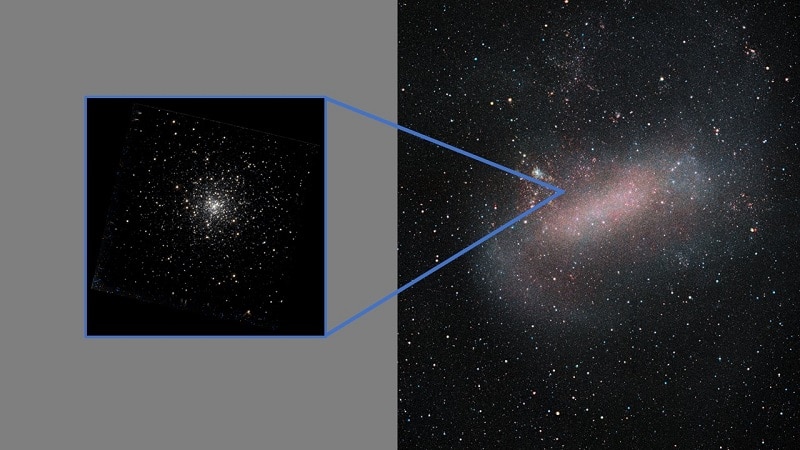
The find confirms the suspicion that small galaxies in turn consist of even smaller galaxies.
We’ve known for some time that our own Milky Way has grown by gobbling up smaller galaxies. Incidentally, in recent years it has become apparent that actually all large galaxies are formed by consuming smaller galaxies. But not only the giants are guilty of this, researchers now prove.
Large Magellanic Cloud
Researchers wanted to a new study demonstrate the conjecture that small galaxies in turn also consist of even smaller galaxies. To test this hypothesis, they studied the Large Magellanic Cloud, a galaxy neighboring our Milky Way.
The Magellanic Clouds are galaxies visible to the naked eye in the night sky. The Large Magellanic Cloud is about 160,000 light-years away and is the third closest galaxy to the Milky Way. The Small Magellanic Cloud is about 200,000 light-years away. Both galaxies consist of hundreds of millions of stars. Until recently, astronomers believed that the Large Magellanic Cloud would continue to orbit the Milky Way for billions of years, or perhaps eventually escape the gravitational pull of our Milky Way. But recent measurements show that the Large Magellanic Cloud contains much more dark matter than previously thought. As a result, the galaxy is drawn towards the Milky Way, as it were. A few years ago, researchers even showed that the galaxy is on a collision course with the Milky Way.
In particular, the team looked at so-called globular clusters: large balls, made up of stars, that revolve around the centers of galaxies. Such a globular cluster consists of hundreds of thousands of – often older – stars. The idea is that the core of such a globular cluster can hold up even after billions of years of pushing and pulling in a galaxy.
Chemical composition
The researchers analyzed the chemical makeup of 11 globular clusters that reside in the Large Magellanic Cloud. They did this using the Chilean Very Large Telescope and the Magellan telescopes. Surprisingly, of the eleven globular clusters studied, one was found to have a markedly different chemical composition: globular cluster NGC 2005.
NGC 2005
Bolhoop NGC 2005 is located 750 light-years away from the center of the Large Magellanic Cloud and contains about 200,000 stars. The globular cluster contains, among other things, less zinc, copper, silicon and calcium than the ten other globular clusters studied.

Composite image of NGC 2005 (left) and the Large Magellanic Cloud (right). The chemical composition of the stars in the star cluster NGC 2005 differs from other stars in the Large Magellanic Cloud. It is the first evidence of merging dwarf galaxies beyond our Milky Way. Image: HLA/Fabian RR/ESO/VMC Survey/Astronomie.nl [CC BY-SA 3.0]
Based on the chemical composition of NGC 2005, the researchers argue that this globular cluster must be a remnant of a small galaxy in which the stars formed quite slowly.
Small galaxy
Billions of years ago, the small galaxy would have merged with the – then not very large – Large Magellanic Cloud. Over time, most of the small galaxy has split apart and most of the stars have become scattered. But the center – globular cluster NGC 2005 – lagged behind.
It means astronomers have found a veritable relic of an ancient merger in the Large Magellanic Cloud. So this neighboring galaxy has indeed incorporated an even smaller galaxy from a different environment, confirming the researchers’ hypothesis. Researcher Davide Massari, who works in Italy and at the University of Groningen, is delighted. “We have now convincingly demonstrated for the first time that small galaxies near our Milky Way are in turn made up of even smaller galaxies,” he concludes.
Source material:
“Dwarf galaxy captures star cluster ” – Astronomie.nl
Image at the top of this article: ESO/VMC Survey